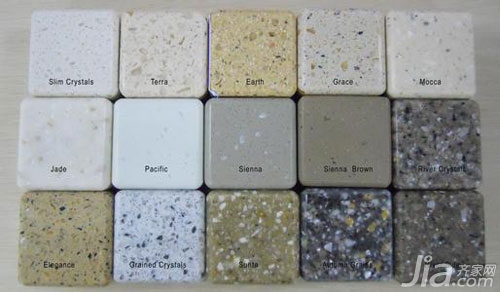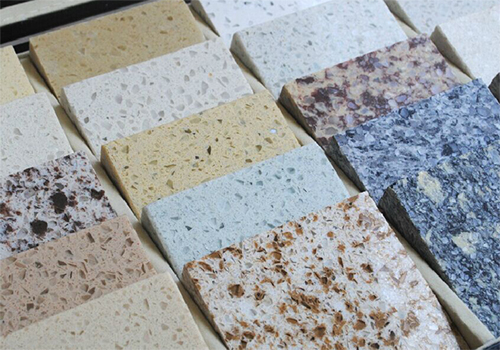Artificial stone introduction:
Artificial stone is based on unsaturated polyester resin as binding agent, together with natural marble or inorganic powders such as calcite, silica, sand, and glass powder, as well as suitable flame retardants, colors, etc., mixed by ingredients, cast by porcelain, Vibration compression, extrusion and other methods formed by curing. Compared with natural stone, artificial stone has bright colors, high gloss, uniform color, pressure wear resistance, toughness, compact structure, strong and durable, light weight, non-absorbent, erosion-resistant weathering, small color difference, no fading, radioactive Low-level advantages. With the advantages of comprehensive utilization of resources, it has a role that can not be underestimated in environmental protection and energy conservation, and it is also a veritable building green product. Has become the preferred decorative material for modern architecture.
Artificial stone usually refers to artificial stone solid surface material, artificial stone quartz stone, artificial stone granite and so on. Different types of artificial stone, its composition is not the same. The composition is mainly resin, aluminum powder, pigments and curing agents. It is a new type of environmentally friendly composite material. Compared to traditional building materials such as stainless steel and ceramics, artificial stone is not only versatile, it is rich in color, and it has a wider range of applications. Artificial stone is non-toxic, radioactive, flame-retardant, non-stick oil, non-porous, antibacterial, mildew-proof, wear-resistant, impact-resistant, easy maintenance, seamless splicing, and varied shapes. At present, domestic artificial stone industry has just started and most emerging companies are still in the learning stage.
Artificial stone types:
1. Artificial stone is a "polymer polymer", usually based on unsaturated resin and aluminum hydroxide filler material, the polymer solid board formed by stirring, shallow injection, heating, polymerization, etc. Generally known as: "resin board artificial stone."
2. Man-made stone based on "Methyl methacrylate" (MMA), also known as acrylic artificial stone. Represented by DuPont of the United States, few domestic specialized companies such as Yadir can also produce "acrylic" artificial stone.
3. Artificial stone of MMA and resin mixture, which is called A plate in Yadir, is the first practical type of man-made stone interspersed between the above two kinds of artificial stone in the industry.

The use of artificial stone
1, countertops: cabinet countertops, bathroom countertops, sill, dining table, commercial Taiwan, reception counters, desks, computer desks, bar counters and so on.
Artificial stone combines the natural texture and solid texture of marble, the exquisiteness of ceramics and the ease of processing of wood. Its use and promotion symbolizes that the art of decoration has entered a new era of artificial stone and stone from the age of natural stone.
2, sink: washbasin, laundry pool, wash basin and other non-friable, easy to maintain, resistant to old, always bright as new features.Artificial stone use matters needing attention:
One, do not place high temperature objects directly on the table. When placing high-temperature objects, other heat-insulating materials such as brackets, heat-insulating mats, etc. shall be placed under the placed items.
2. Do not use boiling water immediately after rinsing the countertops in cold water to prevent artificial marble countertops from bursting due to sudden and sudden hot surfaces in a short time;
Third, do not directly drag heavy items on the table so as to keep the table clean and beautiful;
Fourth, do not cut the table as a cutting board, picking up various types of items; (Hint: add a rubber mat or towel under the cutting board)
5. Do not allow heavy objects or sharp weapons to impact the surface of artificial stone to prevent it from leaving traces;
6, should avoid the table and some organic solvents, such as paint remover, acetone-containing water, pine perfume, etc., are likely to hurt the smoothness of the table, resulting in stains.
Seven, normal use will not happen. However, if a hot object comes in direct contact, it can easily burst. Remember!
The advantages and disadvantages of artificial stone
advantage:
1, the choice is relatively large, pattern color is more abundant, with heart.
2, artificial stone wear, acid, high temperature, impact, compression, anti-folding and other functions are very strong.
3, renovation is simple, can be polished repeatedly renovation.
4, strong anti-pollution, no surface pores, oil, water stains do not easily penetrate them.
5, can be seamlessly bonded to any length, the same material of the adhesive will be polished after bonding two, seamless, no traces of joints.

Disadvantages:
Naturalness is obviously insufficient and textures are relatively fake.
Price situation:
If the market price is not the brand's general 180-280 yuan / meter, if the import price will be it twice or more, the general domestic brand price is about 300-500 yuan / meter. Specific needs to be determined by the market situation.
Editor reminds: artificial stone countertops according to the number of materials containing acrylic to classify the grade and price, in general, the more acrylic content, the better the quality, the price is higher. It is important to point out that artificial stone panels that claim pure acrylic material do not exist. The regular brands are DuPont Corian, Japan Kuraray, South Korea LG, and West Germany Stone. The knowledge of artificial stone is introduced here. For more information, you can pay attention to the information of this website or go to this website to find more products!
Cabinet Building Materials Knowledge Building Materials Marble Glass Window Paint Decorative Glass Counter Process Glass Marble Cabinet Counter
Ferroalloys, a broadly defined ferroalloy is a product that is used as a deoxidizer, elemental additive, etc. in steelmaking to add iron to certain properties or to meet certain requirements.
Property: The main element of the ferroalloy generally has a high melting point, or its oxide is difficult to reduce, and it is difficult to refine the pure metal. If it is together with the iron, it is easier to reduce the smelting. The use of ferroalloys in iron and steel smelting, in which iron is not only harmless, but because of the fusing of molten steel is more favorable. Therefore, deoxidation and alloying in the steelmaking process are mostly added in the form of iron alloys. Iron alloys are generally brittle and cannot be used as metal materials.
Purpose: As a deoxidizer for steelmaking, silicon manganese, ferromanganese and ferrosilicon are the most widely used . As strong deoxidizers, aluminum (aluminum iron), silicon calcium, silicon zirconium, etc are used . Commonly used alloy additives are: ferromanganese, ferrochromium, ferrosilicon, ferrotungsten, ferromolybdenum, ferrovanadium, ferrotitanium, ferronickel, niobium (neodymium) iron, rare earth iron alloy, ferroboron, ferrophosphorus and so on. A variety of ferroalloys, in accordance with steelmaking needs, are regulated in many grades based on the content of alloying elements or the level of Carbon contained, and the impurity content is strictly limited. Ferroalloys containing two or more alloying elements are called composite ferroalloys. The use of such ferroalloys can add deoxidizing or alloying elements at the same time, which is beneficial to the steelmaking process and enables the more comprehensive and efficient utilization of symbiotic ore resources. Commonly used: manganese silicon, silicon calcium, silicon zirconium, silicon manganese aluminum, silicon manganese calcium and rare earth ferrosilicon.
Ferroalloys
Ferroalloys,Ferro Silicon,Ferro Tungsten,Different Shape Ferroalloys
Hwa Seng Resources (Hong Kong) Co., Limited , https://www.hwaseng-resources.com